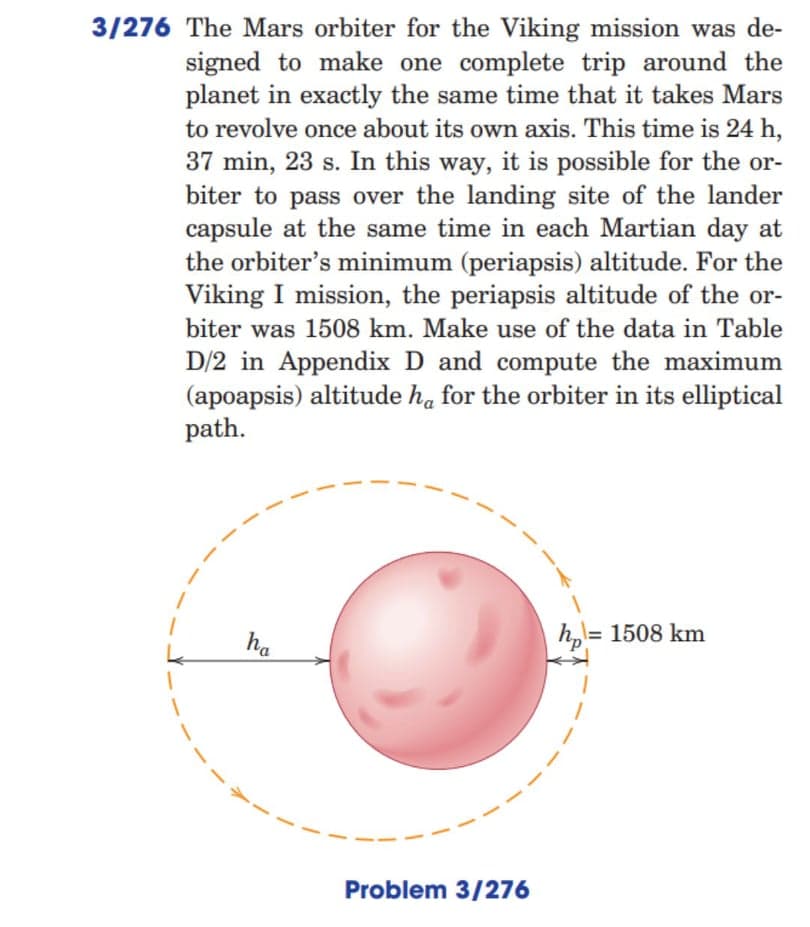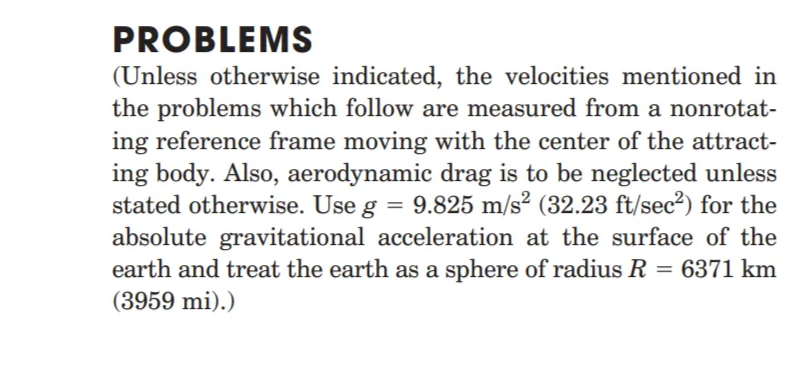3/276 The Mars orbiter for the Viking mission was de- signed to make one complete trip around the planet in exactly the same time that it takes Mars to revolve once about its own axis. This time is 24 h, 37 min, 23 s. In this way, it is possible for the or- biter to pass over the landing site of the lander capsule at the same time in each Martian day at the orbiter's minimum (periapsis) altitude. For the Viking I mission, the periapsis altitude of the or- biter was 1508 km. Make use of the data in Table D/2 in Appendix D and compute the maximum (apoapsis) altitude ha for the orbiter in its elliptical path. ha h,= 1508 km
3/276 The Mars orbiter for the Viking mission was de- signed to make one complete trip around the planet in exactly the same time that it takes Mars to revolve once about its own axis. This time is 24 h, 37 min, 23 s. In this way, it is possible for the or- biter to pass over the landing site of the lander capsule at the same time in each Martian day at the orbiter's minimum (periapsis) altitude. For the Viking I mission, the periapsis altitude of the or- biter was 1508 km. Make use of the data in Table D/2 in Appendix D and compute the maximum (apoapsis) altitude ha for the orbiter in its elliptical path. ha h,= 1508 km
University Physics Volume 1
18th Edition
ISBN:9781938168277
Author:William Moebs, Samuel J. Ling, Jeff Sanny
Publisher:William Moebs, Samuel J. Ling, Jeff Sanny
Chapter13: Gravitation
Section: Chapter Questions
Problem 86CP: Using Figure 13.9, carefull sketch a free body diagram for the case of a simple pendulum hanging at...
Related questions
Concept explainers
Topic Video
Question
Answer: ha= 32 600 km

Transcribed Image Text:3/276 The Mars orbiter for the Viking mission was de-
signed to make one complete trip around the
planet in exactly the same time that it takes Mars
to revolve once about its own axis. This time is 24 h,
37 min, 23 s. In this way, it is possible for the or-
biter to pass over the landing site of the lander
capsule at the same time in each Martian day at
the orbiter's minimum (periapsis) altitude. For the
Viking I mission, the periapsis altitude of the or-
biter was 1508 km. Make use of the data in Table
D/2 in Appendix D and compute the maximum
(apoapsis) altitude ha for the orbiter in its elliptical
path.
ha
h,= 1508 km
Problem 3/276

Transcribed Image Text:PROBLEMS
(Unless otherwise indicated, the velocities mentioned in
the problems which follow are measured from a nonrotat-
ing reference frame moving with the center of the attract-
ing body. Also, aerodynamic drag is to be neglected unless
stated otherwise. Use g = 9.825 m/s² (32.23 ft/sec²) for the
absolute gravitational acceleration at the surface of the
earth and treat the earth as a sphere of radius R = 6371 km
(3959 mi).)
Expert Solution
This question has been solved!
Explore an expertly crafted, step-by-step solution for a thorough understanding of key concepts.
This is a popular solution!
Trending now
This is a popular solution!
Step by step
Solved in 5 steps with 5 images

Knowledge Booster
Learn more about
Need a deep-dive on the concept behind this application? Look no further. Learn more about this topic, physics and related others by exploring similar questions and additional content below.Recommended textbooks for you

University Physics Volume 1
Physics
ISBN:
9781938168277
Author:
William Moebs, Samuel J. Ling, Jeff Sanny
Publisher:
OpenStax - Rice University

Classical Dynamics of Particles and Systems
Physics
ISBN:
9780534408961
Author:
Stephen T. Thornton, Jerry B. Marion
Publisher:
Cengage Learning

Principles of Physics: A Calculus-Based Text
Physics
ISBN:
9781133104261
Author:
Raymond A. Serway, John W. Jewett
Publisher:
Cengage Learning

University Physics Volume 1
Physics
ISBN:
9781938168277
Author:
William Moebs, Samuel J. Ling, Jeff Sanny
Publisher:
OpenStax - Rice University

Classical Dynamics of Particles and Systems
Physics
ISBN:
9780534408961
Author:
Stephen T. Thornton, Jerry B. Marion
Publisher:
Cengage Learning

Principles of Physics: A Calculus-Based Text
Physics
ISBN:
9781133104261
Author:
Raymond A. Serway, John W. Jewett
Publisher:
Cengage Learning

Glencoe Physics: Principles and Problems, Student…
Physics
ISBN:
9780078807213
Author:
Paul W. Zitzewitz
Publisher:
Glencoe/McGraw-Hill